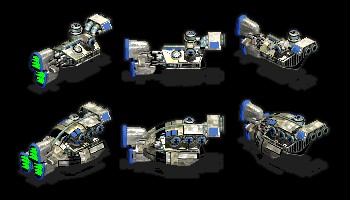

The massive fin at the stern of the Acclamator-class contained both the anti-gravity generator and the ship's hyperdrive generator. The secondary thrusters did not provide as much power, but were useful for maneuvering due to being placed further away from the ship's main axis. The ship's main thrusters were fitted with eight electromagnetic rudders that deflected the exhaust particle streams and gave boost when turning the ship. Secondary reactors were located towards the bow of the vessel. The tanks were connected to the main reactor via pipe assemblies. The tanks compressed hypermatter to enormous density for storage. The Acclamator-class's main reactor was located in the middle of the vessel, inside the main superstructure, and was preceded at the frontal half of the ship by multiple fuel tanks. The later Acclamator II-class could also serve as star frigates to support their landing groups. Groups of these ships could perform a " Base Delta Zero", an orbital bombardment that would exterminate all life on the planet. Fusion rockets fired by enemy forces barely made a scratch on the hull as a result. The hull armor of Acclamator-class vessels was impregnated with ultra-dispersive neutronium that withstood and spread massive energy blasts. Armed with 4 heavy torpedo launch tubes 24 point-defense cannons, rated at 6 megatons per shot and 12 quad turbolaser turrets, each rated at a maximum of 200 gigatons per shot. Offensive and defensive systems ĭespite being largely transports for land forces, these ships were armed well enough to engage in planetary bombardment or ship to ship engagements. The two levels were connected with elevator platforms. A lower, smaller hangar area was used to embark and disembark ground troops and material via a large ramp when landed. Gunships were suspended along an overhead circulating rail in the upper hangar for maintenance procedures during travels. Eighty Low Altitude Assault Transports, of which around 66 were infantry gunships and around 14 were vehicle carriers, were carried to insert personnel, vehicles, and cargo into battle zones in addition to providing close air support. Įach Acclamator-class ship held 320 speeder bikes, used by clone troopers for fast battlefield reconnaissance and patrol duties. In addition to ground landings, Acclamator-class ships were capable of water landings, as displayed at the Battle of Mon Calamari. They also carried eighty aircraft and eighty-four armored vehicles, such as the AT-TE and SPHA walkers, used to provide clone troopers with heavy battlefield support. Complement Īcclamator-class ships had berths for sixteen thousand clone troopers, the equivalent of an entire legion or brigade and its support personnel. Sensor and communications suites were located at the front of the ship's command tower. The bridge crew usually consisted of fully-armored clone pilots manning the control panels, with most operators being seated in twin crew pits below the command officer's area.
SHADOW ERA MOST POWERFUL CLASS WINDOWS
The main bridge and command center had no windows but relied upon advanced holoscreens shaped like the triangular viewports similar to the ones on other Kuat vessels. This tower module was a standard design for smaller ships in Kuat Drive Yards's starship catalog, which Rothana supplied vessels to. The bridge was located in the middle of an arrow-shaped command tower module that protruded from the dorsal superstructure. Most of the passenger and barrack decks were located on the upper levels of an Acclamator-class ship.

The underside of the Acclamator was dominated by a large assault hangar capable of offloading an entire legion of clone troopers and their vehicles in short order.

This basic design was used in a number of larger craft pre-dating it and would define Imperial ships for decades to come. Consequently, the Acclamator favored a wedge or dagger shaped design due to its effectiveness-it allowed concentration of firepower while minimizing target profile. Its mission profile required it to both carry troops and engage enemy starships: the Acclamator was designed to assault contested systems, break hostile orbital blockades, and land troops directly on the battlefield. The Acclamator-class assault transport was 752 meters long, 460 meters in width, and 200 meters in height. Cut-away of an Acclamator, showing (from left to right): The hyperdrive, hypermatter reactor core, hangar area, fuel silos



 0 kommentar(er)
0 kommentar(er)
